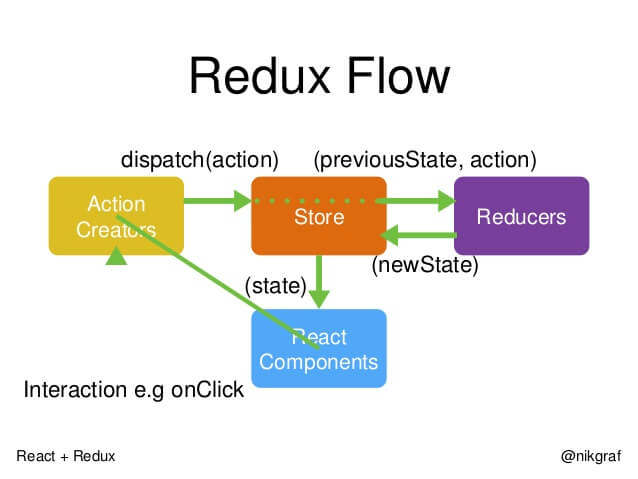在学react的是,发现一旦我们封装好了我们的组件,那么我们的项目就跟搭积木一样简单快速,可是我们发现了一个问题,在一个页面往往会嵌套很多的组件,子组件必须要通过父组件传递参数才能渲染出数据,我们回想一下我们之前构建过的所有react应用,数据都是由最顶层父组件(页面组件)一层层向下传递的。
这也是深层次的组件之间通讯困难的原因:数据的传递是单向的,子组件的数据只能就近获取,但是真正的数据源却离得太远,没有捷径可以直接通知数据源更新状态。
redux的出现改变了react的这种窘迫处境,它提供了整个应用的唯一数据源store,这个数据源是随处可以访问的,不需要靠父子相传,并且还提供了(间接)更新这个数据源的方法,并且是随处可使用的!

用户看到的是能是我们的页面,那么用户如何跟我们的数据互动呢。首先初始化页面,我们会渲染store里面的初始数据,
store 是redux提供的唯一数据源,它存储了整个应用的state,并且提供了获取state的方法,即
store.getState()。现在用户点击了某个按钮,那么这个时候用户就触发了一个动作,称之为action,action只是记录了你刚才"做了什么动作",但是就是知道你干了这个事情,至于事情会发生什么作用,这个并不是你说的算的,就要引入我们的reducer了,如果说action就是你平常做的事,那么reducer就是国家的法律,根据你的事法律会给你相应的后果。
1.我们先看action
action是一个对象,记录本次事件的类型,以便对应相应的结果,除了type属性的其他属性我们称之为载荷(payload),除了type属性外,其他属性都是非必选的。
{ type: 'CHANGE_LIST', data: [1,2,3,4]//这个是假数据,这里当做需要变成的数据,一般是后台拿到的 }
接下来我们要触发这个事件
2.在redux中触发这个事件的方式就是:
dispatch({ type: 'CHANGE_LIST', data:[1,2,3,4] })
3.到这里我们触发了事件,那么事件会产生啥效果呢,这里就提到我们的reducer
假设我们现在有一个列表组件,那么它的数据格式应该可以如下:
// store.getState() { list: { products:['name','age','haha','gege'] } }
现在我们做了步骤2的action操作,那么reducer应该是这样的:
function reducer(state, action) { switch (action.type) { case 'CHANGE_LIST': return { list: { products:action.data//修改给定的数据 } } default: return state // 没有匹配的action type,返回原来的state } }
到此为止我们知道这个操作会产生的效果就是原来的数组products从 ['name','age','haha','gege'] 变成了 [1,2,3,4]。
4.拆分reducer
我们在react真实的项目肯定包含许多的组件,不能把所有组件的reducer写在一个函数里面,这样会显得更复杂以及文件特别大,所以我们把上面的reducer改写一下
function listReducer(state, action) { switch (action.type) { case 'CHANGE_LIST': return { products:action.data//修改给定的数据 } default: return state // 没有匹配的action type,返回原来的state } } function reducer(state, action) { return { list: listReducer(state.list, action), } }
可以看出达到的效果是一致的,刚好redux为reducer的合并提供了一个简单的方法combineReducers,
function list(state, action) { switch (action.type) { case 'CHANGE_LIST': return { products:action.data } default: return state // 没有匹配的action type,返回原来的state } } function dialog(state, action) { switch (action.type) { case 'SHOW_DIALOG': return { status: true } case 'CLOSE_DIALOG': return { status: false } default: return state // 没有匹配的action type,返回原来的state } } export default combineReducers({ list, dialog })
5.生成store,在我们项目的入口文件app.js中:
import React, { Component, PropTypes } from 'react'
import ReactDom from 'react-dom'
// 引入redux
import { createStore, applyMiddleware } from 'redux'
import { Provider, connect } from 'react-redux'
// 引入reducer
import * as reducers from './redux/reducer.js'
import { combineReducers } from 'redux'
//引入组件
import Index from './component/index.js'
//把多个组件的reducer合成总的reducer
const reducer = combineReducers(reducers)
// 创建store,这个是整个应用唯一的
const store = createStore(reducer)
ReactDom.render(
<Provider store={store}>
<Index />
</Provider>,
document.getElementById('root')
)
然后看看我们的Index组件是个啥样子:
import React, { Component } from 'react'
import { connect } from 'react-redux'
import List from './list.js'
class Index extends Component {
constructor(props) {
super(props);
}
render () {
return (
<div>
<List />
</div>
)
}
}
function mapStateToProps(state) {
return state //对应本组件需要的传入的props
}
export default connect(mapStateToProps)(Index)//关联到store上
下面最重要的看看List组件:
import React, { Component } from 'react'
import PropTypes from 'prop-types'
import { connect } from 'react-redux'
class List extends Component {
constructor(props) {
super(props);
}
render() {
var html = this.props.products.map(function(val,i) {
return <li key={i}>{val}</li>
})
return (
<div>
<ul>
{html}
</ul>
<button onClick={this.props.change}>改变数组</button>
</div>
)
}
}
function mapStateToProps(state) {
var info = state.list
return {
products:info.products//对应本组件props需要的属性products
}
}
function mapDispatchToProps(dispatch) {
return {
change () {//这里change方法对应的是这个组件需要外部传入的change方法
dispatch({
type: 'CHANGE_LIST',
data:[1,2,3,4]
})
}
})
}
}
}
export default connect(mapStateToProps,mapDispatchToProps)(List)
这里只是简单介绍了redux基本知识,但是在实际的项目中如何应用呢,实际的项目react和redux结合如何搭建框架呢,这个下篇文章将会列出一个真实的项目。